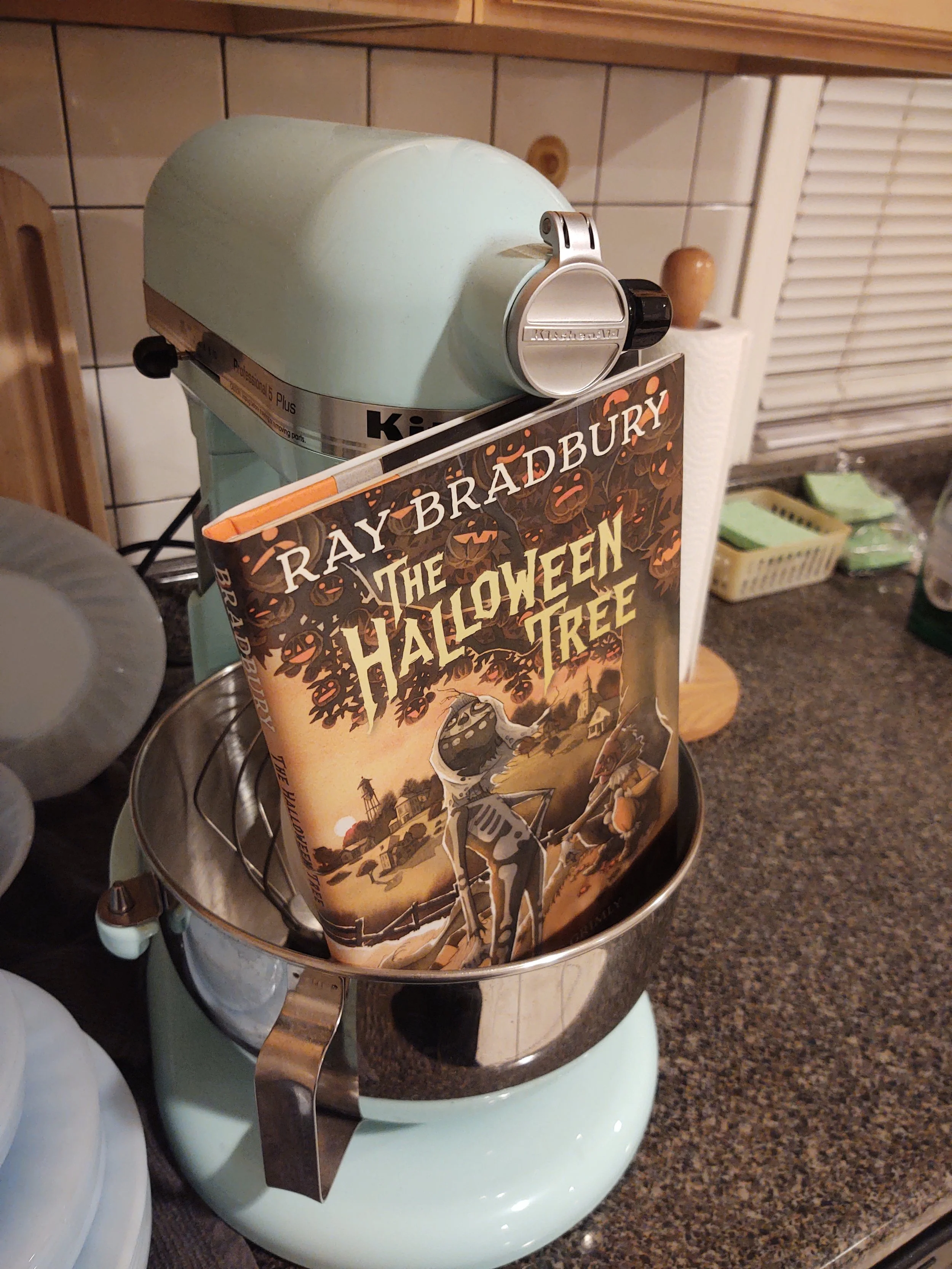Welcome to In-the-Mix Mondays!
My goal here is to highlight some of my favorite titles or at least ones that I found curious. While these reviews aren’t for titles hot off the press, it is important to remember the titles that have helped shape who we’ve become.
The Halloween Tree
It’s Halloween time!
Hold on. I know what you’re thinking: recommending a Ray Bradbury book during October, how gauche! But hear me out, this one is a real treat—The Halloween Tree.
This book is an interesting case study for me as I actually discovered the animated film adaptation (aired on ABC in 1993) before I read the book. After my first watch, I was enchanted by this story. Then, years later, I found out it was based on a novel. Of course, there are differences between the two versions. The most obvious change is the reduction of characters, as the book centers around nine children, and the film pulls that number back to five.
Okay, let me back up for those unfamiliar with The Halloween Tree and give a brief summary. In a charming, bucolic town on Halloween, a group of local children gather to trick-or-treat. Before taking off, however, they realize that one of their numbers is missing—Pipkin, or Pip, the boy who loved Halloween the most. Tragically, Pipkin has fallen deathly ill. The children spot an ambulance taking Pipkin to the hospital and try to follow after it. During the pursuit, they catch sight of a spectral version of Pip racing across a ravine.
They give chase. The specter leads them to a tall, dark mansion resembling a classical haunted house. Outside the intimidating domicile stands a tree with jack-o’-lanterns hanging from its branches—a Halloween tree. Then, the group meets the house’s owner, Carapace Clavicle Moundshroud, voiced by Leonard Nemoy. Moundshroud is also after the specter of Pipkin because he has stolen a pumpkin from the tree. The children convince Moundshroud to take them with him. He agrees, and they are whisked away to learn the meaning of Halloween and find their friend Pip.
The structure of their journey centers around the children's costumes. For instance, one of the kids is dressed like a mummy, so they travel to ancient Egypt. Another is costumed like a skeleton, and they voyage to Mexico to experience el Día de Muertos, the Day of the Dead. At each stop, the group learns how a different culture approaches the ritual of death.
Now, I’m talking about Ray Bradbury here, not some cultural scholar. I’m sure not every detail is exact, but The Halloween Tree isn’t about precision. It is about the spirit of Halloween, one man’s love letter to the season. As an adult, the first time I watched this movie, I wanted to dig out an old costume, pick up a handled plastic pumpkin, and relive that childhood wonder.
But what about the writing, you ask? Since this book was published in 1972, do I lambaste it for lacking the more modern ideals of diversity and inclusion? Or do I bend the fan-boy-knee before the idol of Bradbury? Well, neither, actually. As I said, I first encountered The Halloween Tree as a movie, not knowing its literary heritage or that Bradbury had written the screenplay itself. But I fell in love with the story. As a reader, I personally find his work hit-or-miss. I truly enjoy several of his short stories, but still haven't made it through Something Wicked This Way Comes.
Regarding the writing, there is one thing that brings both the book and the film adaptation together: the opening line. And it is one of my favorite opening lines in all of fiction.
"It was a small town by a small river and a small lake in a small part of a Midwest state." Stop. Now, read it again. Slower. It shouldn't work. But it does. There isn't any action, no characters are introduced, no stakes are raised, and even the sense of place is nebulous. Then, the repetition of "small" was repeated four times. It isn't even a fifty-cent word! Now, go back and read it a third time, but out loud. The sentence sings. It is pure lyrical literature at its best.
Overall, I tend to view the book as the expanded universe of The Halloween Tree story since the movie has a much tighter narrative structure. So, I would recommend that if you have any young children, this is a mandatory October viewing. Then, when they mature a little, get them the book. There is a new hardcover version out with illustrations by Gris Grimly that makes a great gift.
I wish you all a fun and spooky Halloween.
See you In-the-Mix!
The Heart of a Witch
Hello all! Let me announce the first In-the-Mix Monday! In honor of the season, today’s short review is The Heart of a Witch by Judith Hawkes.
Welcome to the very first In-the-Mix Monday! This series will highlight books that made me fall in love with writing all over again.
Since the Spooky Season is upon us, I decided to kick things off by introducing The Heart of Witch by Judith Hawkes. Set in 1950s upstate New York, the story follows twins Shelley and Kipling. Growing up in the sleep town of Green Hollow, the twins engage in the usual juvenile antics, but the secretive Lockley Arms Inn across the street from their house becomes the object of their fascination.
In their teens, Shelley and Kipling uncover that the inn is home to a coven of witches, traditional practitioners of Wicca. But when the children of Green Hollow start disappearing, the twins find themselves swept up in supernatural intrigue that could cost them more than just their lives.
I wish I could tell you where or when I discovered this book (probably after its 1999 publication date). Have you ever found yourself browsing the store shelves when, without rhyme or reason, your hand is drawn to a particular title? Some of the best stories I've ever read have come to me this way, and I suspect that is how I came to The Heart of a Witch, especially since I have yet to read Hawkes’ other two novels, Julian’s House and My Soul to Keep. Although, I’ve heard great things about both of them.
As a child of the '80s and '90s, I don't have many touchstones for the 1950s besides reruns of Happy Days. However, Hawkes has structured her tale so that the decade is a pleasant backdrop to the more significant actions of the characters and does not depend upon the reader's knowledge of the decade. All one must know is that the story takes place before the advent of cell phones and the internet when we still visited the library to research. The book’s timeline revolves around the Wiccan holidays, and I do enjoy Hawkes’ descriptions of the changing New England seasons. To a degree, weather is the most essential part of the setting in The Heart of a Witch.
The perspectives in this narrative change from third-person omniscient, first-person, and first-person retrospective. This might sound like too much for a single novel, but the alternating viewpoints let the reader become more invested in the characters' emotional lives. The transition between perspectives is so well crafted that I hardly notice the switch unless I am looking for it.
Every few Halloweens, I snatch The Heart of a Witch off my shelf for a reread. I guarantee you'll enjoy reading about Shelley and Kipling on a cool October afternoon. Pick up some cider or a pumpkin-spiced latte and embark on a fantastic journey.
See you In-the-Mix!


